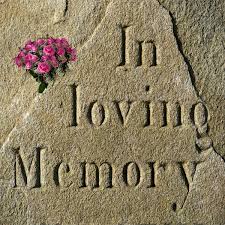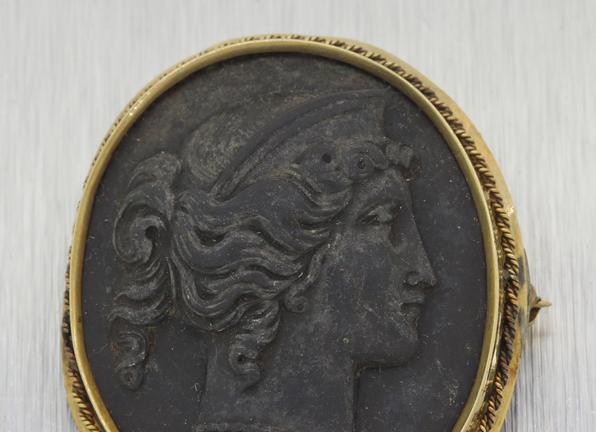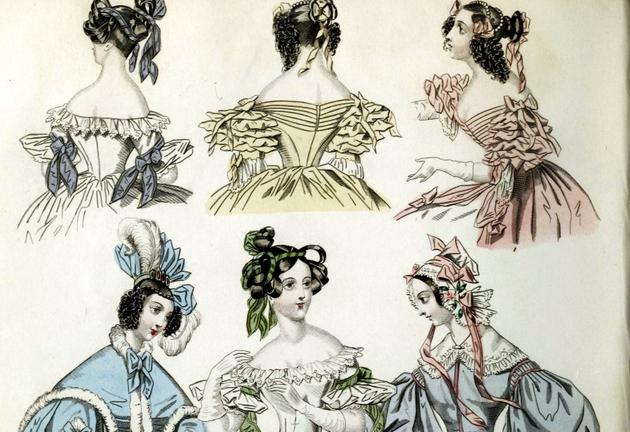Mourning Custom and Ritual

by Sally Norton, First published for the September/October 2007 issue of Finery
Victorian mourning customs seem strange to us now, but they grew out of centuries of social ritual. Formal mourning was observed in England for royalty and nobles in Medieval times. As with other practices, those who could afford to copied the upper crust.
The 19th century brought together several trends. The sentimentalism of the romantic era (1830-1840) encouraged people to express their grief. Increased wealth allowed the middle classes to spend more on funeral observances. The industrial revolution increased the ability to manufacture goods for niche markets. When Queen Victoria went into permanent mourning for Prince Albert in 1861, the formalities intensified. The restrictions gradually lessened at the end of the 19th century, fading away completely with the horrors of the Great War.
19th Century Mourning
Mourning was social; it had very little to do with the church. In 19th century Anglo-American society, etiquette books spelled out specific attire for each stage of bereavement. The most intense mourning customs were reserved for the ties of husband and wife or parent and child.
Mourning attire was easier for men: a black armband on an already-black suit. Women spent a year and a day in black crepe, then lightened progressively to black without crepe, then to grays and lavenders when in mourning for a husband, child or parent. For other relations, one went directly into the later stages of mourning dress (grays and lavenders).
Jet jewelry was considered appropriate for mourning because, like crepe, it was not reflective. Hair jewelry was popular as a remembrance in days before photography. Hair jewelry is not exclusively mourning jewelry. It was also considered an appropriate gift to a family member leaving on a journey and moving some distance away.
Mourning emporiums supplied not only attire, but accessories and even black bordered stationary (the depth of the border indicating your degree of bereavement). Burial societies helped the working poor provide decent funerals.
Gravestones and Monuments
The funerary architecture of the 19th century is a monument to the Victorian age and attitude toward death. Cemeteries became big business in the 19th century. They were designed by fierce rivals and given enthusiastic promotional campaigns by eager entrepreneurs.
A walk through a 19th century cemetery affords vistas of elaborate tombs, winding avenues, and curious monuments all pointing to the material prosperity and variable taste of the age. At every tum, the visitor is confronted by draped urns, obelisks pointing toward the sky, numerous clasped hands, Celtic crosses and miniature Gothic spires. What does it all mean? For us, it is a confusing jungle or a romantic idyll depending upon one’s personal predilection.
To the 19th century mindset, all of these extraordinary examples of the stonemason’s art were symbols. Their meanings were easily understood. Today, we need help decoding the symbolism. Our attitudes toward death and death rituals are vastly different from the Victorian era.
Victorian writers gave full rein in their descriptions of funerals, black-robed mourners, and the ever-changing company of pale faces and troubled hearts at the resting place of Death and Sorrow. This is unlikely to be an accurate description today. We are not insensitive to twinges of regret when reading gravestones, but we do not fully understand what is being expressed in the effusive decoration.
The following list is a terse description of the kinds of monuments found in most 19th century cemeteries. It is intended only as an introduction and is, by no means, definitive.
Symbols and Meanings
Angel flying — Rebirth
Angel trumpeting — Call to the Resurrection
Angel weeping — Grief
Arch — Victory of Death or Victory in Death
Bird — Eternal life
Birds in flight — Flight of the Soul
Candle or flame — Life
Columns & Doors — Heavenly entrance
Crown — Glory of life after death
Dove — Purity & Devotion
Figs or Pineapples — Prosperity and Eternal Life
Flower — Frailty of Life
Flower, Severed Blossom — Mortality
Garland — Victory
Hand pointing — Heavenly reward
Heart — Love, Mortality, Love of God
Hourglass — Time’s inevitable passing
Lamb — Innocence
Pall, Pick or Spade — Mortality
Rooster — Awakening, the Resurrection
Scythe — Death, the Divine Harvest
Shell — The Resurrection, Life Everlasting
Skull, Skeleton — Mortality
Sun setting — Death
Sun shinning/rising — Renewed life
Tree — Life
Tree sprouting — Life everlasting
Tree, severed branch — Mortality
Vine — The Sacraments
Weeping willow — Nature’s lament
Winged Face — Effigy of the soul of the Deceased
Winged Skull — Flight of the soul from mortal man
Wreath — Victory
Wheat Sheaves — The Divine Harvest






Leave a comment